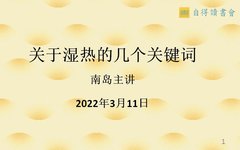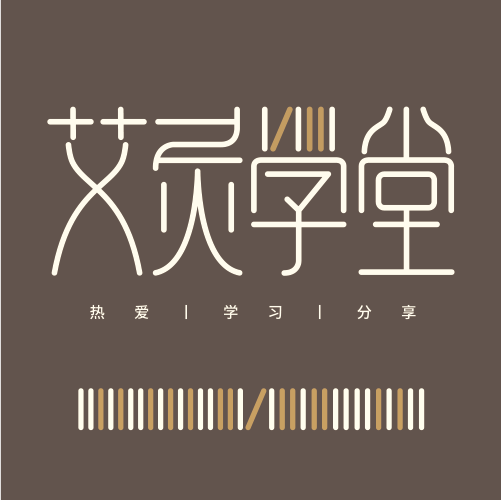
On March 11, 2022, I gave a public lecture in a live video session, explaining methods to cope with damp-heat issues at home. After the live session, several enthusiastic friends (who have established the Zide Editorial Department and are continuously recruiting like-minded individuals) helped transcribe the recording into a manuscript. I then adapted the manuscript, removing unnecessary language and expanding on unclear explanations, to share with everyone.
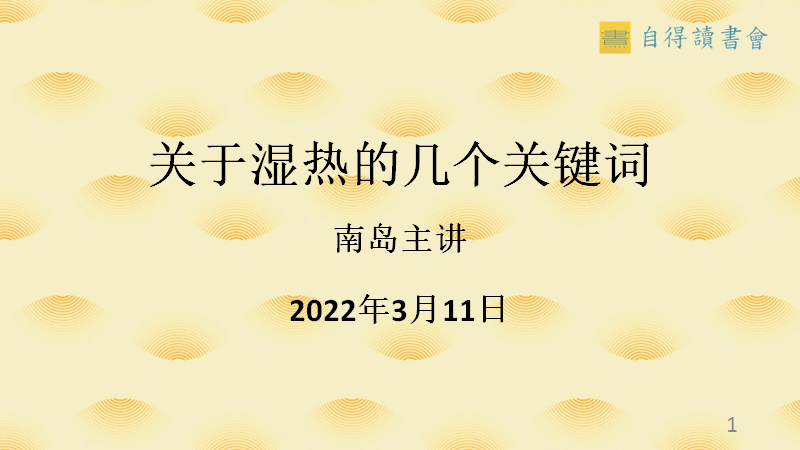
Tonight’s topic will cover several key terms related to damp-heat.
Recently, many people have consulted me about damp-heat issues, so I decided to give a public lecture where everyone can learn more useful knowledge during the session.
For tonight’s lecture, I have prepared an outline:
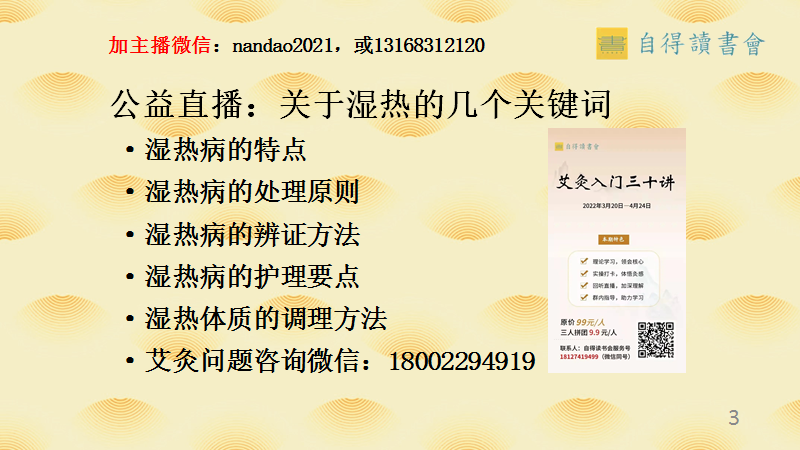
The theme for tonight is the characteristics of damp-heat syndrome. Here, we will discuss the acute form of damp-heat syndrome. What are the characteristics when it develops acutely?
The second topic will be the treatment principles for damp-heat syndrome, the third will be the diagnostic methods for damp-heat syndrome. Using the correct diagnostic methods will lead to significant treatment effects. The fourth topic will cover the nursing principles for damp-heat syndrome, which has high requirements for nursing. If nursing is not done well, damp-heat syndrome can easily recur. Finally, we will discuss chronic damp-heat issues, specifically the conditioning methods for damp-heat constitution.
If you encounter moxibustion issues at home, you can add this WeChat number, 18002294919, for free consultation. I will only tell you where to moxibust, but I won’t analyze your body or explain why certain points are chosen, as I don’t have the time, and the knowledge gap is too large. Finding a doctor to prescribe a formula is possible, but they won’t tell you why they prescribed it, right?
Now, let’s begin with the first part of the content: the characteristics of damp-heat syndrome:
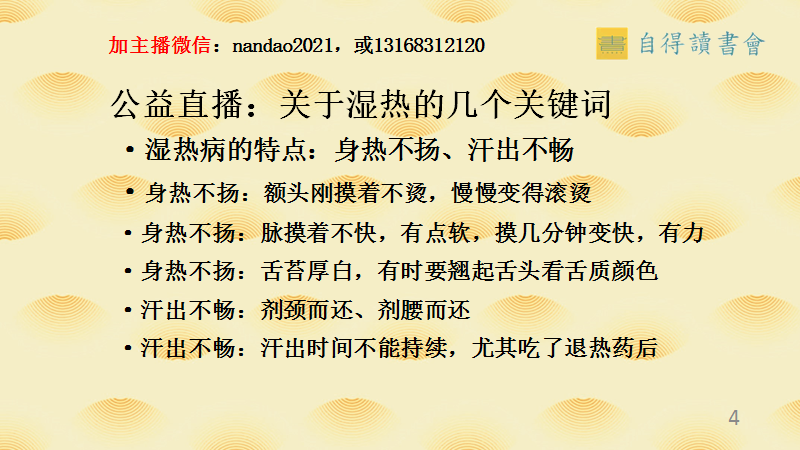
Damp-heat syndrome has eight key characteristics: “body heat not rising, sweating not smooth.”
On the surface, these phrases seem understandable. “Body heat not rising” means that the heat in the body does not rise, right? “Sweating not smooth” means that sweating is not smooth, correct?
However, these eight characters have profound implications, which we will gradually elaborate on.
“Body heat not rising” is like when a child at home has a fever. When you touch their forehead, at first it may not feel very hot, not burning hot, but after a while, you feel that the heat seems to seep out more and more, and eventually, it can even feel a bit scorching. This is the first meaning of “body heat not rising”; at first, the skin does not feel hot, but the longer you touch it, the hotter it becomes.
“Body heat not rising” also refers to checking the child’s pulse. The requirements for pulse checking are not high; just count how many times the child’s pulse beats in a minute. This is always possible, right? In the first minute, it might be over 80 beats, but in the third minute, it can reach 120 beats. A fast pulse reflects internal heat, but this heat feels like it is slowly seeping out, which is also part of the meaning of “body heat not rising.” From the pulse, you can also feel that the child’s pulse is not very strong at first, but it becomes stronger the more you check it. This reflects “body heat not rising” in terms of pulse quality.
We can also observe the tongue. We will show you some typical tongue images of damp-heat syndrome later. Sometimes the tongue coating is quite thick, making it difficult to see the color of the tongue body underneath. Often, the coating is thick and white—heat can also be accompanied by yellow coating. At this time, you might mistakenly think it is cold-dampness. You need to lift the tongue to see the color of the tongue body, which is very red, indicating heat wrapped in dampness. This is also part of the meaning of “body heat not rising.”
Therefore, regarding “body heat not rising,” we have introduced the pulse and tongue signs; everyone should grasp these three implications well.
Next, let’s look at “sweating not smooth.”
“Sweating not smooth” refers to the area of sweating not being widespread, the duration of sweating not being sustained, and the sweating time being too short.
“Sweating not smooth” can be very typical, with sweating occurring only above the neck or above the waist, while below there is no sweating. The texts mention: “sweating from the neck and above, and returning from the waist and above,” meaning sweating occurs above but not below. In a normal person, sweating should occur on the thighs and calves, with the amount of sweat being about one-third of the body.
The body is divided into two halves; sweating above indicates that the heat pathogen is rising and forcing the fluids outward, while no sweating below indicates that the damp pathogen is descending and obstructing the flow of Qi, preventing sweating. This is a unique aspect of damp-heat syndrome.
Dampness tends to descend, and those who sit for long periods are most prone to this issue. When dampness descends, some women may experience itching in the lower genital area, while others may have thick thighs, with dampness tightly wrapped around, causing the legs to not sweat at all. The skin on the legs becomes hard, and this has been previously discussed; moxibustion on Yaoyangguan can help to promote Yang and drain dampness, while also helping to slim the thighs.
“Sweating not smooth” also manifests in terms of time, where sweating does not last long. If a child has a fever, experienced parents know to give them antipyretics, and soon the child will sweat, but the sweating lasts for a very short time, less than two hours, and the sweat is generally quite profuse.
Profuse sweating can expel cold, but it is not suitable for expelling dampness, so it appears that after the child takes the antipyretic, the temperature drops to around 38.2°C or 37.8°C, but does not go down further. Parents may switch between several types of antipyretics over a few hours, but the fever does not completely subside. If the sweating can continue with a light sweat for more than two hours, with sweating occurring on the body and limbs, generally, the damp-heat will reduce significantly.
These are the characteristics of damp-heat syndrome. Let’s look at some typical tongue images of damp-heat.
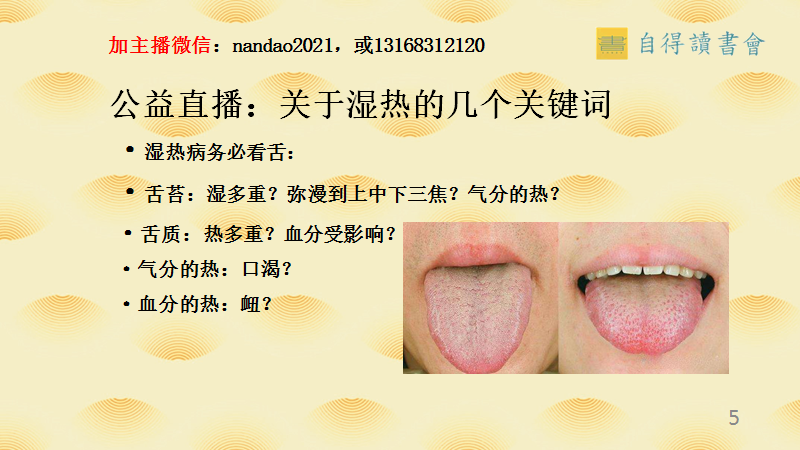
When examining the tongue, we mainly look at two parts: the tongue coating and the tongue body.
When looking at the tongue coating, we assess how heavy the dampness is, mainly by observing how thick and greasy the coating is. The coating in the middle of the right side of the tongue should be thicker and greasier, indicating that dampness is primarily in the middle jiao (spleen and stomach). The coating on the left side covers the entire tongue surface, indicating that damp-heat is diffused throughout the three jiao: upper jiao (heart and lungs), middle jiao (spleen and stomach), and lower jiao (liver and kidneys) (which differs slightly from the physiological three jiao).
If the tongue coating is yellow, it indicates heat in the Qi level, while if the tongue body is red, or if the tongue body has red spots like the one on the right, it indicates heat in the blood level. The Qi level and blood level are like two doors; the Qi level is more superficial, while the blood level is deeper. If there is heat in the Qi level, thirst is more pronounced, while if there is heat in the blood level, although there is dryness, one may not want to drink water. If the heat in the Qi level is not severe, it may be more pronounced with a greasy feeling in the mouth, leading to a lack of appetite or an inability to taste food. If the mouth feels greasy, the entire upper digestive tract is likely also greasy, making it inappropriate to feed the child milk at this time.
Heat in the blood level can easily disturb the spirit, as the heart governs the blood vessels. Heat in the blood level can easily disturb the heart, leading to confusion, delirium, or even coma. Moreover, the pericardium and liver are both jueyin meridians, and jueyin is affected by wind. If a child has heat in the blood level, it can easily lead to convulsions due to the heat disturbing the wind.
Comparing the tongue images on the left and right, the left side shows that the damp-heat is lighter than on the right side. If we observe different times in the same case, we can see changes in damp-heat from the tongue images:
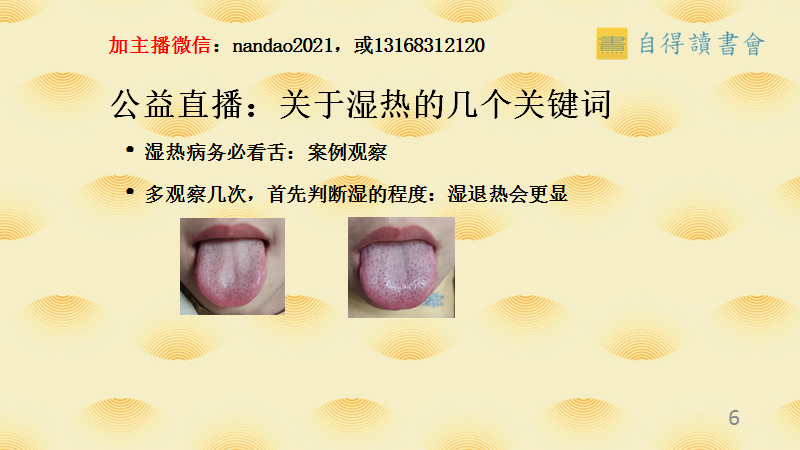
This complete case is recorded in this article (you can click to see), and it can be seen that the coating on the right is not as thick and greasy as on the left, but there are more red spots, indicating that the dampness has dissipated and the heat has emerged.
Next, let’s look at the most critical part: the treatment principles for damp-heat syndrome:

The treatment principles for damp-heat syndrome must be remembered: “remove dampness first, then heat.” First, remove dampness, first remove dampness, first remove dampness.
It cannot be reversed, thinking of removing heat first. First, heat enters dampness, like oil entering flour, it is difficult to separate. Second, dampness is a Yin pathogen, which easily obstructs the flow of Qi. Even if you clear some heat, the dampness will obstruct the Qi flow, causing stagnation of Yang Qi, which will lead to the generation of heat. Therefore, the first step in treating damp-heat syndrome must be to remove dampness; this must be remembered.
The method to remove dampness, as the ancients said, is to treat the lung for damp-heat, which has remained unchanged throughout history. The treatment for damp-heat syndrome starts from the lungs, which is an unchanging principle. First, we need to diffuse the lungs. For example, everyone is familiar with the method of pinching the spine, followed by moxibustion on Shenzhu (Governing Vessel 3). The method of pinching the spine can be referenced: demonstration of spine pinching and the indications for different spine pinching methods.
Grasping Jianjing (Shoulder Well) is done by holding the shoulder well point with both thumbs and pulling upwards; it should be done with a bit of force for better dampness removal. Using a scraping board to scrape around the Jianjing point is also effective.
I often recommend that families with children keep some perilla leaves at home. Fresh or dried, just boil a few perilla leaves for about five to ten minutes, using more water. Use this perilla water to wash the child’s face and upper body, which has a good effect on resolving dampness.
If perilla leaves are not available, mulberry leaves can be used as a substitute for damp-heat issues, but perilla leaves are the first choice. If some children easily experience skin itching on the upper body, they can also wash with perilla water.
The second method for treating dampness is to promote urination. In terms of medication, we mainly use mild herbs that promote urination and drain dampness. This method teaches us that when damp-heat syndrome is severe, we should avoid spicy and heavily flavored foods. Additionally, we should pay attention to providing an outlet for the pathogenic Qi: one is to diffuse the lungs to expel it, and the other is to promote urination to drain dampness, and only then should we tonify the spleen and stomach.
Many people think of tonifying the spleen and draining dampness as the first step when facing dampness. From my personal experience, this method is relatively weak, especially when damp-heat is diffused throughout the three jiao; the first step must be to diffuse the lungs and resolve dampness.
From a preventive perspective, we have seen many stubborn dampness cases, and it is recommended to adjust the body before the onset. For example, in Guangdong, during the rainy season, clothes hung on the balcony feel damp by evening. In such weather, children should avoid certain foods, and dairy products should not be consumed. Some women like to dress lightly, but this can lead to gradual exposure to cold, which can accumulate dampness. Cold dampness can gradually generate heat, turning into damp-heat, so avoiding prolonged exposure to cold is also very important.
Additionally, some people have a long-term greasy tongue coating and a red tongue body, indicating a damp-heat constitution, which requires more attention to conditioning. If a child often has a greasy coating, especially during foggy or rainy weather, in addition to avoiding dairy products, it is best to give them spine pinching every day.
Next, let’s look at the diagnostic methods for damp-heat syndrome.

Damp-heat, remember, has its base camp in the middle jiao, so it is written here that damp-heat accumulates in the middle jiao.
Damp-heat can easily rise and obstruct the upper jiao or descend and cause issues in the lower jiao. What is rising? When the lid of a boiling pot is lifted, steam rises immediately; this is damp-heat rising, which in the body means obstructing the upper jiao (lungs and heart). Obstructing the lungs can lead to coughing, and the lung meridian can also show symptoms like warm hands and feet. Obstructing the heart can affect the spirit, and if the heat is severe, it can lead to madness, causing someone to attack others with a knife.
Descending is a characteristic of dampness. For those who sit for long periods, dampness tends to descend, leading to issues in both the anterior and posterior yin. Men may experience dampness in the scrotum, while women may have increased vaginal discharge, itching in the anterior yin, and some may experience diarrhea or burning sensations in the anus after defecation.
When treating damp-heat, it is important to provide an outlet for the pathogenic Qi. During the acute phase, the main focus is on diffusing the lungs, and a bit of diuresis can be used, primarily through Yaoyangguan. Ye Tianshi stated that promoting Yang is not about warming but about promoting urination; promoting urination is crucial for treating dampness. If urination is continuously smooth, dampness cannot remain and will gradually be metabolized by the body.
When conditioning a damp-heat constitution, we mainly look at where the tongue coating covers. If there is a greasy coating in the lower jiao, it indicates damp-heat accumulation in the lower jiao. Using Yaoyangguan to drain damp-heat is sufficient. If the greasy coating extends to the middle and upper jiao, we must also include Shenzhu (Governing Vessel 3) in the treatment.
Let’s look at some tongue images for a clearer understanding:
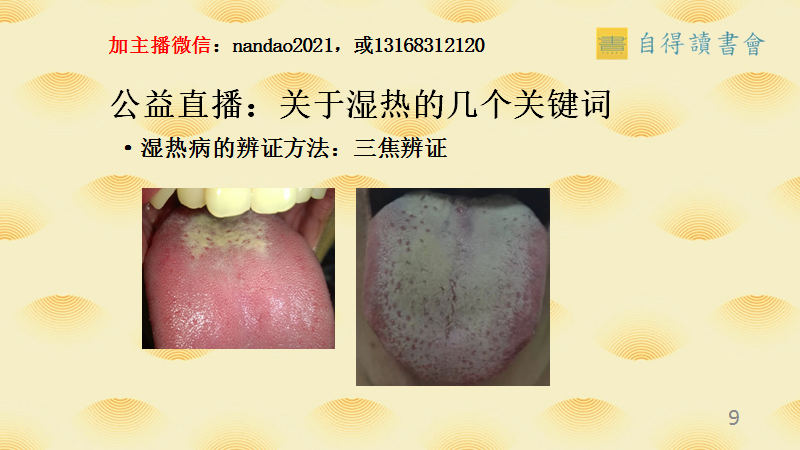
The left tongue image shows that damp-heat is only in the lower jiao; moxibustion on Yaoyangguan or Shuiquan (Water Spring) can be used. The right tongue image shows that damp-heat affects the three jiao; we must also include Shenzhu in the treatment. Diffusing the lungs is the correct treatment method. If both Yaoyangguan and Shenzhu are used together, it will promote lung diffusion and diuresis simultaneously, leading to faster resolution of dampness.
Now, let’s look at the nursing principles for damp-heat syndrome. Good nursing practices can help prevent recurrence.
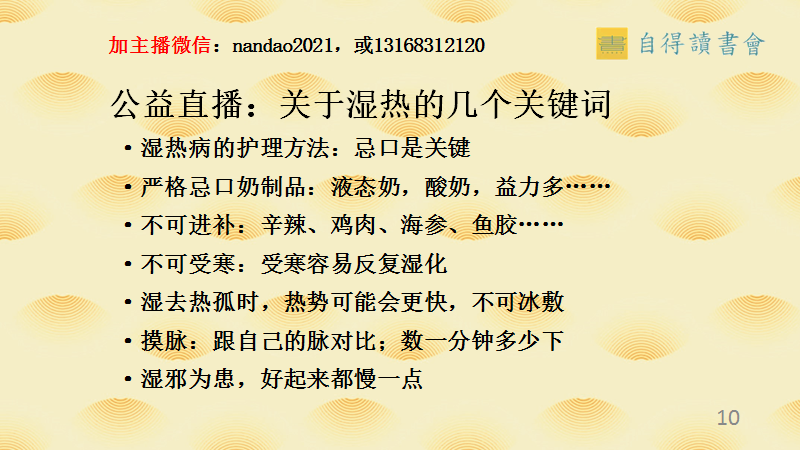
First, dietary restrictions are essential. Strictly avoid dairy products, including liquid milk, yogurt, and probiotic drinks. Avoid them for at least three days. If dairy products are not avoided, it may take thirty days to recover. Secondly, do not over-supplement. Many elderly people think that after a child recovers from an illness, they should cook something nourishing. However, this can lead to problems! Start with a light diet and gradually return to a normal diet. Today’s children generally do not lack nutrition, so there is no need for excessive supplementation. Thirdly, avoid cold exposure. The first step in treating damp-heat is to remove dampness, which may lead to a temporary rise in heat after dampness is removed. If ice packs are applied, or if the child sleeps on the floor or is exposed to cold air, it can easily lead to the accumulation of dampness again. It is best to find a cool place to rest without exposure to cold. Ultimately, dietary restrictions are the root of the problem; they must be taken seriously. Parents should develop the habit of checking their child’s pulse. Regardless of how high the child’s fever is, check their pulse for two key points: how many beats per minute and whether it is stronger than their own pulse. A normal child’s pulse is slightly faster than an adult’s; for example, if a parent’s pulse is 72 beats per minute, a child’s pulse may be 82 beats per minute, which is not a big issue. However, if a child’s pulse reaches 120 beats per minute, it indicates that the pathogenic Qi has not completely subsided, and close monitoring is necessary. A normal child’s pulse is generally softer than an adult’s. If it beats strongly, it indicates that there is still significant pathogenic Qi in the body, which is not a good sign and requires close observation. After removing dampness, if the fever temporarily rises, and the pulse is not fast but soft, there is no need to worry; the heat will subside on its own after a while. Additionally, we must respect objective laws; damp-heat syndrome, or issues with dampness, take time to resolve. Just as pregnancy takes ten months, a child’s recovery from illness also requires time. It is not possible to recover immediately. Understanding the progression of the illness can help shorten the recovery time. Finally, let’s mention the conditioning methods for damp-heat constitution:
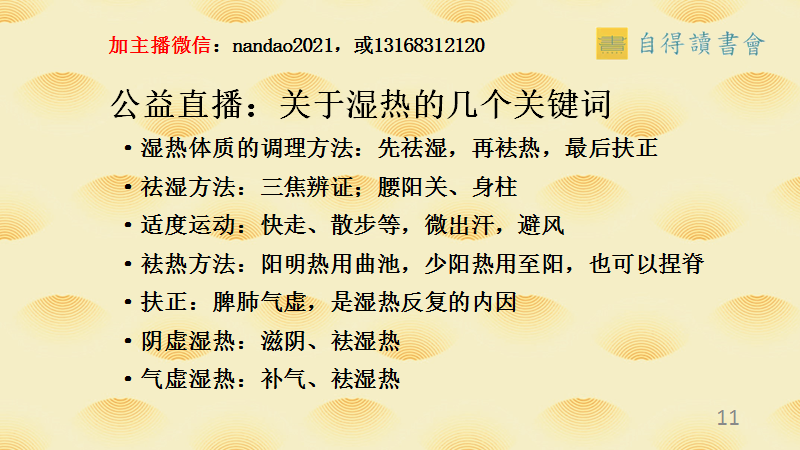 As previously mentioned, Shenzhu and Yaoyangguan will not be repeated. It is important to remind everyone that exercise is very important. Many people think of exercise as running ten kilometers, but it is not like that. You can take a brisk walk for ten minutes or walk for half an hour; that is also exercise. The goal is to induce light sweating, which can help expel dampness from the body. However, be careful to avoid wind during sweating; do not expose yourself to cold air directly. For heat removal methods, if there is Yangming heat, with thirst and profuse sweating on the head and face, these indicate Yangming heat, and we can use Quchi (LI 11) to drain heat. If there is Shaoyang heat, mainly with bitter taste in the mouth, dry throat, and discomfort in the eyes, we can moxibust the Yang points. Pinching the spine until the skin turns red can also help to remove heat. Supporting the body’s Yang is the final step; when the tongue shows no thick or greasy coating, we can support Yang by moxibusting Guanyuan (CV 4) and Zusanli (ST 36), which are more tonifying points. Children can also practice Tai Chi massage. Damp-heat can also be accompanied by other causes, which we will briefly mention; otherwise, we won’t finish. Yin deficiency with damp-heat means that the tongue body is originally red, and with damp-heat, the red spots are not many; this requires attention to using Sanyinjiao (SP 6) as well. Qi deficiency with damp-heat is particularly common in the south, which is why people in Guangdong often use Wuzhimaotao (Five-Finger Peach) in soups to tonify Qi and drain dampness. The wisdom of the common people can sometimes be very effective. The content of the live broadcast is presented above. If you need to re-listen to the live session, you can long-press to recognize the QR code below for free re-listening:
As previously mentioned, Shenzhu and Yaoyangguan will not be repeated. It is important to remind everyone that exercise is very important. Many people think of exercise as running ten kilometers, but it is not like that. You can take a brisk walk for ten minutes or walk for half an hour; that is also exercise. The goal is to induce light sweating, which can help expel dampness from the body. However, be careful to avoid wind during sweating; do not expose yourself to cold air directly. For heat removal methods, if there is Yangming heat, with thirst and profuse sweating on the head and face, these indicate Yangming heat, and we can use Quchi (LI 11) to drain heat. If there is Shaoyang heat, mainly with bitter taste in the mouth, dry throat, and discomfort in the eyes, we can moxibust the Yang points. Pinching the spine until the skin turns red can also help to remove heat. Supporting the body’s Yang is the final step; when the tongue shows no thick or greasy coating, we can support Yang by moxibusting Guanyuan (CV 4) and Zusanli (ST 36), which are more tonifying points. Children can also practice Tai Chi massage. Damp-heat can also be accompanied by other causes, which we will briefly mention; otherwise, we won’t finish. Yin deficiency with damp-heat means that the tongue body is originally red, and with damp-heat, the red spots are not many; this requires attention to using Sanyinjiao (SP 6) as well. Qi deficiency with damp-heat is particularly common in the south, which is why people in Guangdong often use Wuzhimaotao (Five-Finger Peach) in soups to tonify Qi and drain dampness. The wisdom of the common people can sometimes be very effective. The content of the live broadcast is presented above. If you need to re-listen to the live session, you can long-press to recognize the QR code below for free re-listening: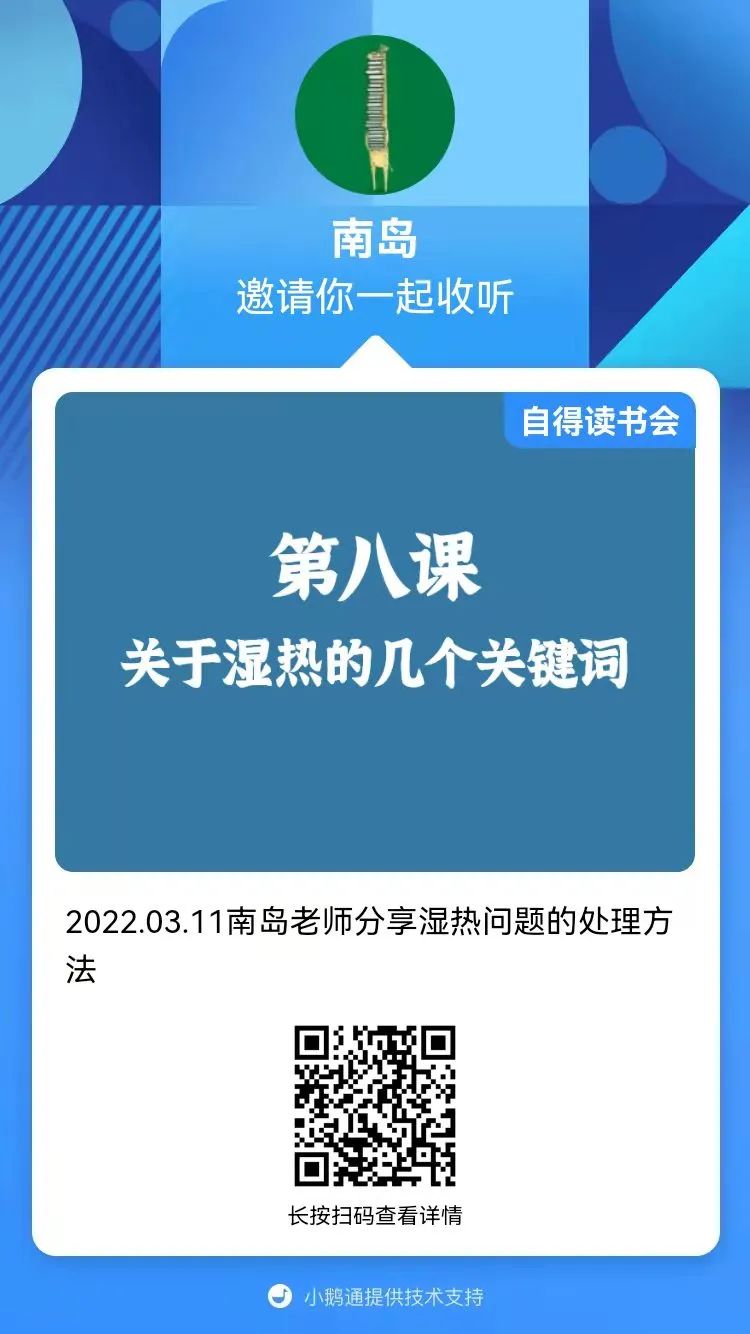 The damp-heat spring and summer are approaching, and this article is very practical. Don’t keep it to yourself; not only learn it a few more times, but also share it with friends and family, so that more people can have the ability to cope with damp-heat issues at home. At critical times, being prepared will naturally lead to stable and reliable treatment effects. My several live broadcasts on the theme of COVID-19 can be rewatched by clicking the links below (limited time free): First session: How to Prevent and Treat COVID-19 at Home Second session: What to Do About Persistent Diarrhea After COVID-19 Third session: How to Efficiently Handle Post-COVID Symptoms with Moxibustion? Post-COVID issue: Where to Moxibust for Persistent Cough After Recovery? Post-COVID issue: How to Restore Male Vitality After Recovery?
The damp-heat spring and summer are approaching, and this article is very practical. Don’t keep it to yourself; not only learn it a few more times, but also share it with friends and family, so that more people can have the ability to cope with damp-heat issues at home. At critical times, being prepared will naturally lead to stable and reliable treatment effects. My several live broadcasts on the theme of COVID-19 can be rewatched by clicking the links below (limited time free): First session: How to Prevent and Treat COVID-19 at Home Second session: What to Do About Persistent Diarrhea After COVID-19 Third session: How to Efficiently Handle Post-COVID Symptoms with Moxibustion? Post-COVID issue: Where to Moxibust for Persistent Cough After Recovery? Post-COVID issue: How to Restore Male Vitality After Recovery?

